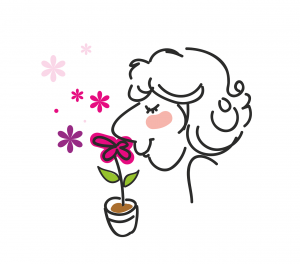Ylang Ylang: Calming the Heart, Mind, and Supporting the Whole Body

Who doesn’t love the scent-sational and alluring odor of ylang ylang essential oil? However, this essential oil has many more uses than a contributing ingredient to the well-known and alluring perfume of Marilyn Monroe. Learn more below.
If you haven’t guessed, ylang ylang is one of my favorite essential oils! In going with the theme of writing about lesser-known oils, with harder pronunciations, I decided to remedy that with not one post, but two!
First, I discussed a little bit about the background of this oil here in part I. If you’ve read it, you’ve learned a lot about the fame of ylang ylang for its scent, but also got your science hat on and discovered the complexity of its makeup. Finally, I provided a teaser on some of its calming, relaxing, and protective effects.
Below I review a little more on the potential uses of this oil and how I suggest my clients integrate this appealing scent into their wellness regime. They smell good and have better wellness, two scores in my book!
More Background on Ylang Ylang
The 2015 abstract from Evidence-Based Complementary and Alternative Medicine states the importance of quality in obtaining a bottle of ylang ylang essential oil. (You can get more of the details in part 1, if you desire.) The article also provides a wonderful summary of this aromatic plant essence’s various properties. It is provided below, with a compliance break, and then continued:
Ylang-ylang (Cananga odorata Hook. F. & Thomson) is one of the plants that are exploited at a large scale for its essential oil which is an important raw material for the fragrance industry. The essential oils extracted via steam distillation from the plant have been used mainly in cosmetic industry but also in food industry. Traditionally, C. odorata is used to treat malaria, stomach ailments, asthma, gout, and rheumatism. The essential oils or ylang-ylang oil is used in aromatherapy and is believed to be effective in treating depression, high blood pressure, and anxiety. Many phytochemical studies have identified the constituents present in the essential oils of C. odorata. A wide range of chemical compounds including monoterpene, sesquiterpenes, and phenylpropanoids have been isolated from this plant. Recent studies have shown a wide variety of bioactivities exhibited by the essential oils and the extracts of C. odorata including…
(Insert FDA more compliant claims in summary below.)
… Thus, the present review summarizes the information concerning the traditional uses, phytochemistry, and biological activities of C. odorata. This review is aimed at demonstrating that C. odorata not only is an important raw material for perfume industry but also considered as a prospective useful plant to agriculture and medicine.
Here’s the summary of ylang ylang’s research findings, in wellness-friendly language:
This essential oil has been found to: inhibit microbes (more effective for gram positive critters over gram negative), prevent biofilm formation (S. Aureus), ease tissue discomfort, act as an antioxidant, support blood sugar, aid healthy skin cell formation, and modulate healthy fertility, (yet may prevent it and be toxic to sperm).
Important Side Note:
The extract has similar properties but not all, there are different constituents. Therefore, when reading literature on essential oils, make sure they are discussing the essential oil, not the plant extract alone.
More on the Benefits of Ylang Ylang

Calm the Heart with Inhaling Ylang Ylang
Ylang Ylang is generally reported to have a calming effect on the heart. In one small study with 29 men, it was shown that the inhalation of ylang ylang oil in a fragranced room for 20 minutes decreased heart rate and lowered blood pressure. The researchers reported on the constituents and methods are followed as described below:
We used the Ylang-Ylang oil containing linalool (13.6%), geranyl acetate (5.3%), caryophyllene (1.7%), p-cresyl ether (16.5%), methyl benzoate (8.7%), benzyl acetate (25.1%), benzyl benzoate (2.2%), and other sesquiterpenes (7.4%). In this study, we put 3 drops (0.15 cc) of Ylang-Ylang oil by using a pipette into a warm water (90°C) lamp and created incense. All of the subjects in YYG smelt a fragrance emerging from the lamp for 20 min.
Now, I wouldn’t advise heating an essential oil, it could damage the constituents! Furthermore, this oil is a little different in some of the constituents of other ylang ylang chemotypes (again, learn more in part I). Still, note the presence of the “active constituents” linalool and sesquiterpenes. Ah-ha!
In a similar study with inhalation of ylang ylang the results also demonstrated relaxing properties. The authors reported the effect to be “harmonization and subjective,” yet, the physiological parameter of blood pressure was indeed affected.
Alas, I only have the abstract, but I believe the authors were supporting the subject’s evaluation of the odor impacting the response.:
Scientific evaluations of the effects of fragrances on humans are rather scarce. The aim of this investigation was to study the effects of ylang-ylang oil (Cananga odorata, Annonaceae) on human physiological parameters and self-evaluation. Twenty-four healthy volunteers participated in the experiments. Fragrances were administered by inhalation. Physiological parameters recorded were skin temperature, pulse rate, breathing rate and blood pressure. Self-evaluation was assessed in terms of alertness, attentiveness, calmness, mood, relaxation and vigor. Additionally, fragrances were rated in terms of pleasantness, intensity and effect. The present investigation showed that ylang-ylang oil may be characterized by the concept of “harmonization” rather than relaxation/sedation. Compared to an odorless placebo, ylang-ylang oil caused significant decreases in blood pressure and pulse rate as well as significant increases of subjective attentiveness and alertness. Correlational analyses revealed that the observed effects are mainly due to a subjective odor experience. (Bolding my emphasis)
Holistic Calming- Combing the Heart, the Mind, and Decreasing Stress
But wait!
Ylang ylang isn’t just for supporting heart health.
One small study with ten volunteers compared the physiological impact of sniffing three different essential oils (a form of tea tree, patchouli, and ylang ylang). The researchers measured effects on various biological markers. The results indicated that ylang ylang (C. odorata) decreased pulse rate, lowered blood pressure, had a relaxing effect, reduced the stress index, and lowered stress response in the brain (increased alpha brain activity.)
In another study with 40 subjects, transdermal (application on the skin) of ylang ylang oil was also reported to lower the blood pressure and increase skin temperature. The subjective measures of relaxation and calmness also improved.
Relax the Nerves, But Careful of Memory
So we know this oil could calm our hearts and heads and modulate stress patterns.
In a comparison study of 144 volunteers assigned to a control condition or one with peppermint and ylang ylang demonstrated that ylang ylang had a calming effect. Compared to peppermint, it also exhibited a decrease in memory. I view this as a nervous system effect, although the authors did not measure neurotransmitters modulated.
Clinical Pearl:
For my clients, I am always taking into account the nervous system effects of essential oils and how using calming oils may have an impact on memory that temporarily decreases it. For example, I will tell my clients if they are using lavender in the morning, to also use a stimulating oil, such as peppermint, with it so their work performance will get the calming benefits with memory enhancement. It may not be “validated,” but I find it helps.
Summary:
Have I got your attention about ylang ylang?!
This essential oils is not just for perfume, although, it is an amazing and non-toxic scent for the ladies. It is also calming to the heart, head, and whole body.
For those wishing to calm their minds, support their physical and environmental health, and enhance their allure, I suggest inhaling and/or diffusing this pleasant aroma daily.
Just think, February is almost over, but thanks to ylang ylang, the romance doesn’t have to die!
Disclaimer
This information is applicable ONLY for therapeutic quality essential oils. This information DOES NOT apply to essential oils that have not been tested for purity and standardized constituents. There is no quality control in the United States, and oils labeled as “100% pure” need only to contain 5% of the actual oil. The rest of the bottle can be filled with fillers and sometimes toxic ingredients that can irritate the skin.
This material is for information purposes only and is not intended to diagnose, treat, or prescribe for any illness. You should check with your doctor regarding implementing any new strategies into your wellness regime. These statements have not been evaluated by the FDA.
The research studies do not necessarily reflect a specific brand or manufacturer of essential oils. You are responsible for obtaining the quality and type of essential oils in your cabinet!




2 Comments